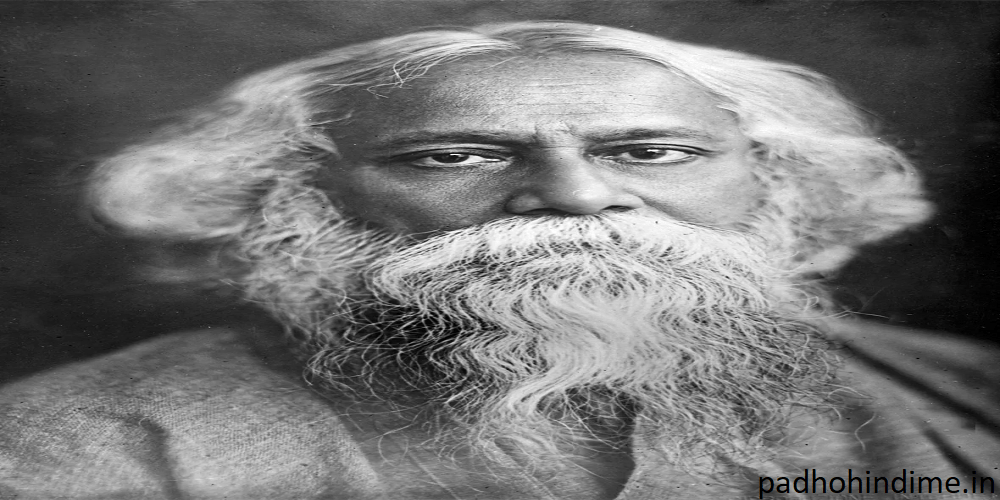Biography Of Rabindranath Tagore.
Introduction:
Rabindranath Tagore, often referred to as Gurudev, was a polymath, poet, philosopher, musician, and artist from India. He is hailed as one of the greatest literary figures of the 20th century, whose influence extended far beyond his native country. Tagore’s immense contributions to literature, music, and art earned him the prestigious Nobel Prize in Literature in 1913, making him the first non-European recipient. This biography delves into the life, works, and legacy of Rabindranath Tagore, spanning his early years, artistic journey, socio-political views, and lasting impact on Indian and global culture.
Early Life and Family Background:
Rabindranath Tagore was born on May 7, 1861, in the bustling city of Kolkata (formerly Calcutta), West Bengal, India. He hailed from a distinguished Bengali family, known as the Tagores, who were part of the Brahmo Samaj, a religious and social reform movement. Rabindranath was the youngest of thirteen children born to Debendranath Tagore and Sarada Devi. His father, Debendranath, was a revered philosopher, poet, and one of the key figures in the Brahmo Samaj movement. The rich intellectual and cultural environment at home played a significant role in shaping Tagore’s creative inclinations.
Education and Early Works:
Tagore’s formal education began at the age of eight when he was sent to a local English-medium school, but he soon moved away from the conventional education system and received most of his education at home. He was a voracious reader, exploring a wide range of literary works, both in English and Bengali. Tagore’s early exposure to a diverse array of literature influenced his writing style and themes.
At the tender age of sixteen, Tagore published his first collection of poems under the pseudonym “Bhānusiṃha” (Sun Lion). The publication, titled “Bhānusiṃha Hṛdaya” (The Heart of Bhānusiṃha), reflected his youthful exuberance and showcased glimpses of his poetic genius. The collection received critical acclaim, paving the way for Tagore’s future literary endeavors.
Santiniketan and Visva-Bharati:
In 1901, Tagore founded an experimental school called Santiniketan, situated in the serene countryside of Bolpur, West Bengal. It aimed to provide a holistic education that harmoniously blended the best of Eastern and Western philosophies. Santiniketan quickly evolved into an intellectual hub, attracting scholars, artists, and thinkers from around the world. Tagore’s vision of education at Santiniketan emphasized the importance of nurturing an individual’s artistic, intellectual, and spiritual growth.
In 1921, Santiniketan expanded and transformed into Visva-Bharati University, an institution that combined the ideals of a traditional gurukul (Indian ancient learning center) with modern educational principles. Tagore’s emphasis on holistic education, artistic expression, and the celebration of cultural diversity became the foundation of Visva-Bharati’s curriculum, which attracted students from various corners of the globe.

Literary Masterpieces:
Rabindranath Tagore’s literary output was prodigious, comprising poetry, short stories, novels, plays, and essays. His works showcased a deep understanding of human emotions, nature, and spirituality, often drawing inspiration from his personal experiences and the socio-political climate of his time. Some of his notable works include:
- Gitanjali (Song Offerings): Published in 1910, Gitanjali is a collection of poems that brought Tagore international acclaim. It was translated into many languages and established his reputation as a remarkable poet. The collection’s lyrical verses, infused with themes of love, spirituality, and universal human experiences, struck a chord with readers worldwide.
- Ghare-Baire (The Home and the World): Published in 1916, Ghare-Baire is a novel that explores the complex dynamics of love, friendship, and nationalism. Set against the backdrop of the Indian independence movement, the story delves into the lives of three main characters, highlighting their personal conflicts and ideological dilemmas.
- Chokher Bali (A Grain of Sand): Originally published in 1903, Chokher Bali is a novel that examines the themes of love, desire, and betrayal. The narrative unfolds around the lives of four individuals, exploring the consequences of their choices and the societal restrictions placed on women in 19th-century Bengal.
- The Post Office: Written in 1911, The Post Office is a play that explores the innocence and imagination of a young boy named Amal, who is confined to his home due to illness. Through Amal’s interactions with various visitors, the play addresses themes of mortality, freedom, and the power of human connection.
Social and Political Engagement:
Rabindranath Tagore’s contributions extended beyond the realm of literature and art. He was an active social reformer and a staunch advocate for Indian independence. Tagore voiced his concerns about the oppressive British colonial rule through his writings, public speeches, and involvement in nationalist movements. However, he also promoted the idea of cultural exchange and understanding between India and the rest of the world.
Tagore’s belief in the universality of human values and the power of education as a tool for social change prompted him to engage in various socio-political issues. He voiced his opinions on women’s rights, education reform, caste discrimination, and the empowerment of rural communities. His progressive views and commitment to social justice continue to inspire generations.
Legacy and Global Impact:
Rabindranath Tagore’s influence transcends borders and generations. His literary works have been translated into numerous languages, making them accessible to people from diverse cultural backgrounds. Tagore’s emphasis on spiritual and emotional experiences, connection with nature, and celebration of humanity resonates with readers worldwide.
The establishment of Visva-Bharati University stands as a testament to Tagore’s vision of education, fostering an environment where students can explore their artistic and intellectual potential. The university continues to shape the minds of young individuals, nurturing creativity, critical thinking, and cross-cultural understanding.
Moreover, Tagore’s musical compositions, known as Rabindra Sangeet, have become an integral part of the cultural fabric of Bengal. These songs, with their poetic lyrics and soulful melodies, evoke a sense of nostalgia, love, and longing.
Conclusion:
Rabindranath Tagore’s life and works illuminate the beauty of human emotions, the importance of cultural exchange, and the pursuit of knowledge. His poetic genius, artistic endeavors, and socio-political engagement have left an indelible mark on the literary landscape of India and the world. Through his literary creations and his commitment to education and social reform, Tagore continues to inspire individuals to strive for a more inclusive, compassionate, and harmonious world.





Pingback: Motivational Story For Students - Padho Hindi Me